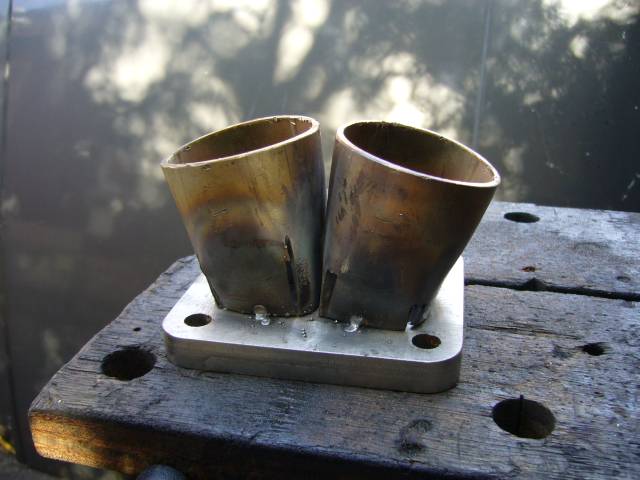| Home > RX-7 > My RX-7 > Project Tina > Project Tina, June 5th, 2007: Looming The Wiring Harness, Coolant Recovery Bottle, Wheel painting, Big Turbo Exhaust Manifold Fabrication |
| Home > RX-7 > My RX-7 > Project Tina > Project Tina, June 5th, 2007: Looming The Wiring Harness, Coolant Recovery Bottle, Wheel painting, Big Turbo Exhaust Manifold Fabrication |
Last time we sort of left off in a bit of frustration dealing with a defective o-ring on the Mallory fuel filter, and having issues getting insurance. The o-ring issue was solved with a local replacement, and insurance was obtained after jumping through some hoops.
With the mechanical glitches fixed, I was actually able to drive the car for the first time in about 4 years for the remainder of November and a little bit of December. I used this time to break in the engine and tune the low load areas in the fuel map. Once the weather turned cold and snow as imminent, the car was garaged and the work you see in this thread began...
The previous thread left off with a shot of the passenger side of the engine bay, completed and ready for the first startup.
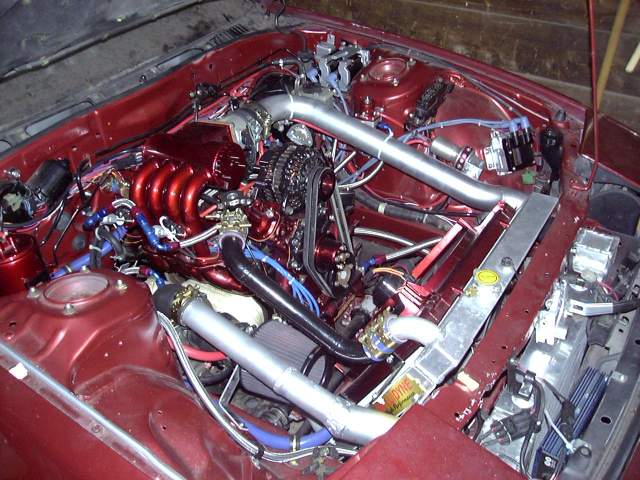
This image should have been in the last thread, but it took a while for the person behind the camera to email me the image. It's rare that there's an actual whole picture of me in one of these threads, so I present a picture of myself TIG welding the intercooler outlet pipe.
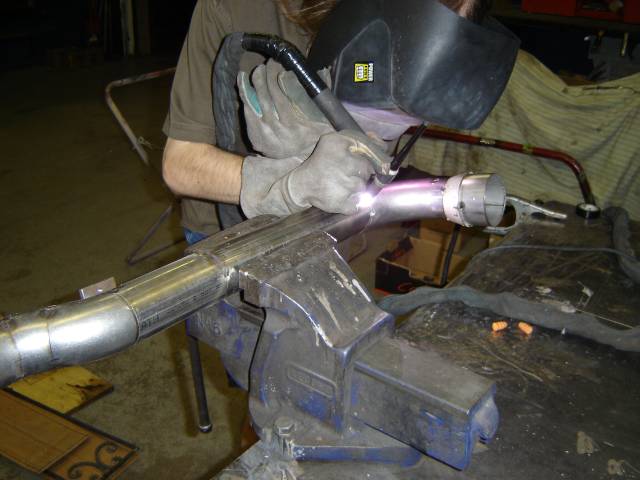
Before the car could be driven, a few minor tasks needed to be completed. One of them was to mount a coolant recovery bottle. Here's the aluminum bracket I made to mount it to the side of the e-fan.
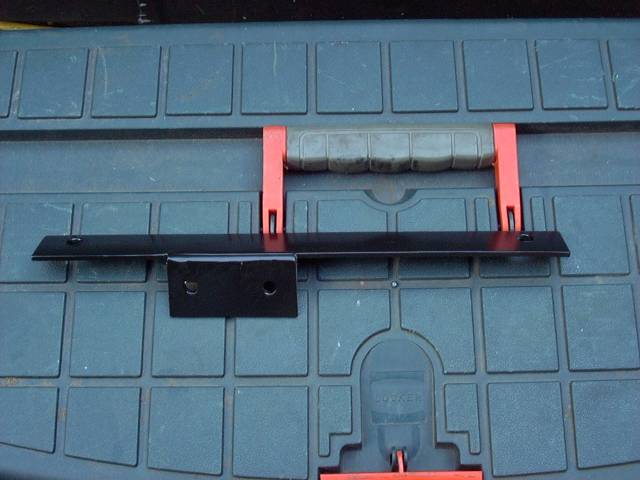
The coolant bottle was then installed. It was not plumbed at this time as I was waiting for some fittings to come in.
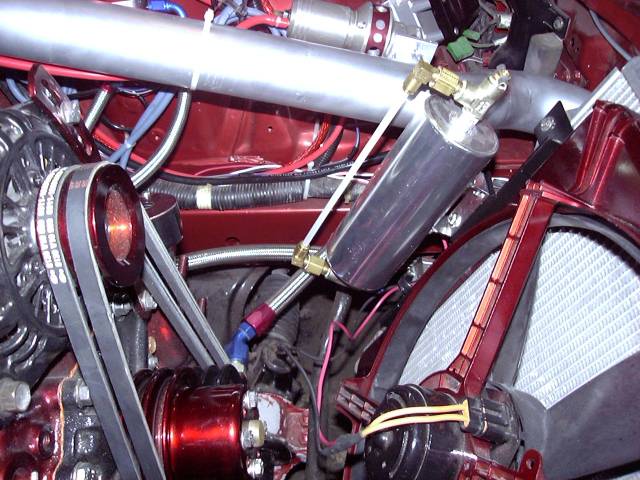
After the bottle was mounted, I loomed and wrapped the wiring harness. There are a lot of ways to do this but I prefer to keep it simple; the wires get put into split loom corrugated tubing, and then the tubing is wrapped with heat and oil resistant electrical tape. I tend not to run wires past major heat sources so I've generally not found the need for thermal wrap. I've also included a few extra wires in the harness in case I need to make additions later.
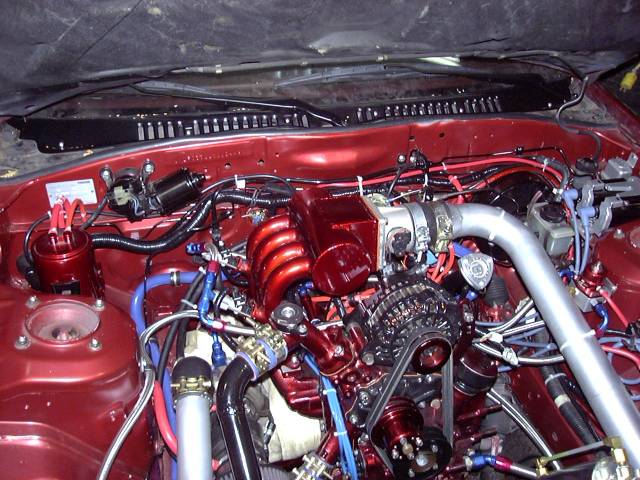
Once the fittings arrived I made a -4 braided stainless line to bring coolant to the recovery bottle. The hole at the pressure cap of the Fluidyne rad is actually tiny 1/16 NPT, so a trip to the hydraulic store was necessary for an adapter to convert it to the more standard 1/8" NPT. From there, a 1/8" NPT to -4 flare adapter allows connection of a 120 degree -4 hose end. The other end connects to the bottom of the recovery bottle via a 90 degree -4 hose end and a -4 flare to 1/4" NPT adapter.
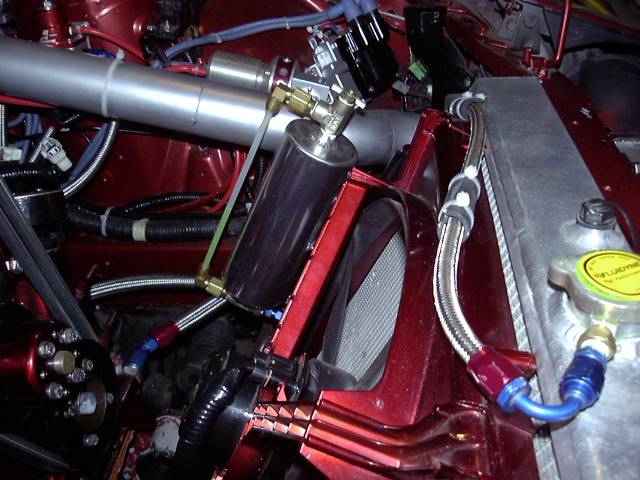
Here's a closeup showing the wicked-cool sight glass I had the hydraulic shop piece together for the coolant bottle. They used some opaque nylon tubing, and an assortment of fittings to put it together.
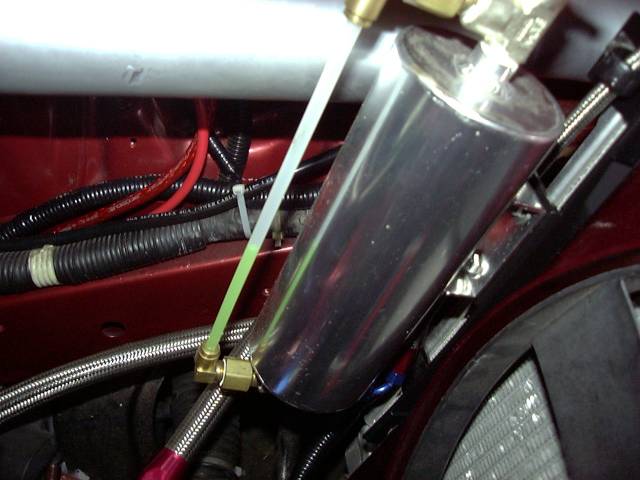
And at that point, I could drive the car. So I did. I put about 600KM on it before the winter and thoroughly enjoyed doing so. The car at that point was very evil with a tiny and responsive turbo (I couldn't stay out of boost in 5th on the highway, and just revving in neutral would spool up about 6 PSI at low throttles), virtually no interior, no radio and an insanely loud exhaust (straight pipe all the way back to two straight-through mufflers). While I drove the car I did some minor tuning and ended up with a fairly passable low-load map. I didn't want to get too much into boost as my wideband had not arrived so I only tuned up to about 6 PSI. Still, even that little amount of boost (which came on instantly at any more then 20% throttle) was plenty of fun considering I had not driven the car in years.
Only a few minor problems crept up, which I think is pretty good considering the amount of work done to the car. I need to replace my metering oil lines. The lines I rebuilt leak like hell around the nipples. So I'm just going to buy new lines from Mazda to avoid the frustration of re-rebuilding them. I also seem to have an oil leak from the front eccentric bolt that leaks about a drop or two of oil every half hour. Just enough to make a mess when slung around the engine bay. I'll need to pull the hub bolt and replace the o-ring and crush washer.
Once the winter started, the car was prepared for storage and put in the garage.
With all the work done I really didn't have anything to do during the first few winter months so I just ordered parts. The first was the most exciting being that it was the new turbo. I went through a lot of thought in deciding what I would run, looping through the common choices. TO4 (and it's many variations)? Nah. Twin S5 turbos? Nah. GT35? Nah. With the exception of using two S5 turbos as twins, all of these turbos are common and have been played out. Not at all saying they are poor choices but I'm also looking for something more unique. I took a brief look at the GT42 but that thing is huge. I knew I wanted to stick with a ball bearing turbo so I called up my friends at ATP Turbo and ordered this:
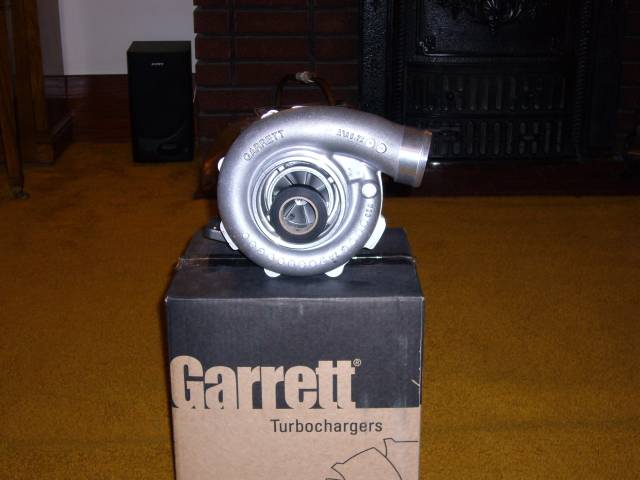
That's a GT4088R (dual ball bearing) with an 88MM compressor and 0.72 A/R housing, 77MM turbine wheel with a 1.06 hotside. The turbine inlet is divided TO4 and the outlet is a 3" v-band setup. Compressor inlet features the typical 4" "anti surge" design with a 2.5" outlet. The hotside is a bit smaller then people would typically run on a bridgeport but I'm OK with loosing a little potential at the top end of the turbo to maintain instantaneous response.
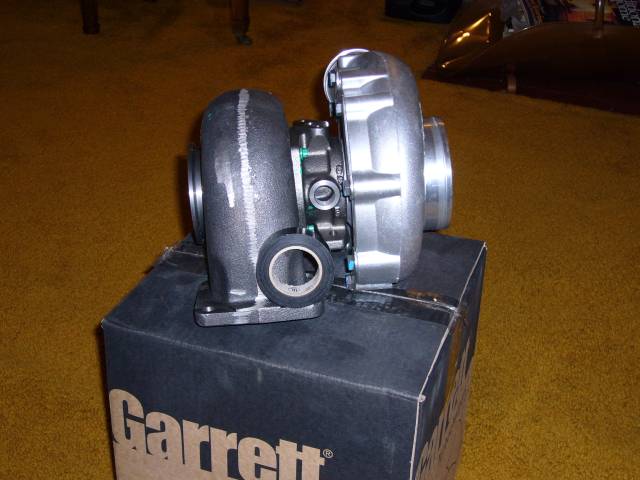
At this point it's mid February and the winter is dragging on. The winter was fairly mild with afforded more then a few days in which I could work comfortably in the garage. The first of which I spent pulling the wheels, cleaning them up, and then sending them off to the media blaster. About a week later I received my fully blasted wheels.
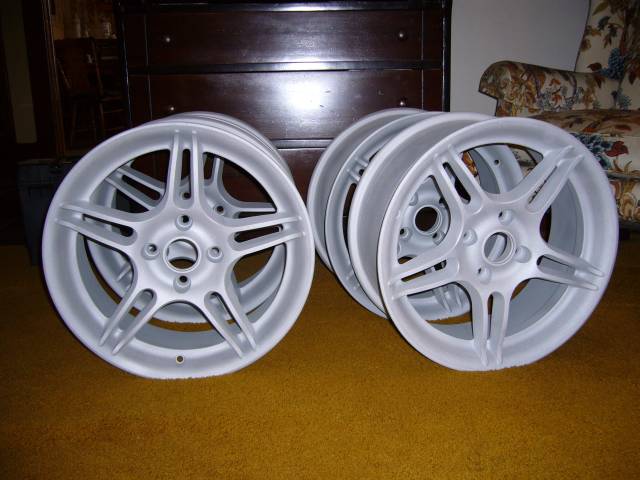
Time to paint. To paint the wheels I chose Hardnose Paint made by the POR-15 company. I've always been happy with their products and the Hardnose paint is advertised as "Too tough to chip!". It says so right on the can. Along with the paint it's important to have the right accessories. Plenty of paintbrushes, measuring cups, and puppy cups to mix paint in. Puppy cups tend to work better then other animals for this, not sure why. The Hardnose is a two part paint with an additional hardener/activator that gets mixed in when it's ready for use. Like all of the POR-15 products, Hardnose can be brushed or sprayed and will lie perfectly flat afterwards. I chose to brush since I don't have the equipment to spray safely.
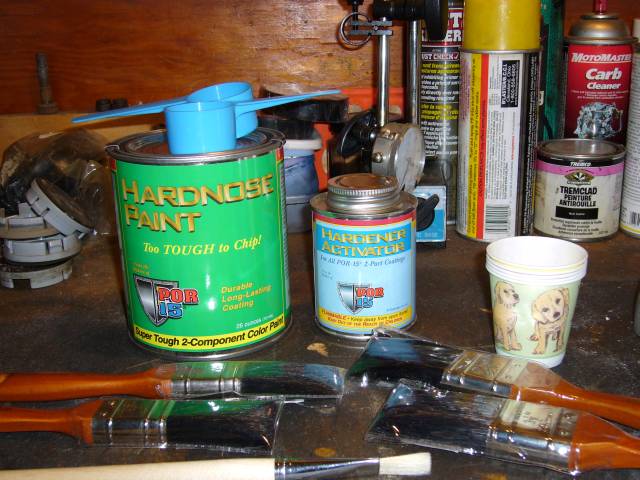
Wheels are a real pain to paint due to the intricate lines and tight spaces. To make access easier I made a small adapter that fits on my engine stand. It bolts through a lug hole to the back of the wheel and makes it easy to access both sides while being able to rotate the wheel as well.
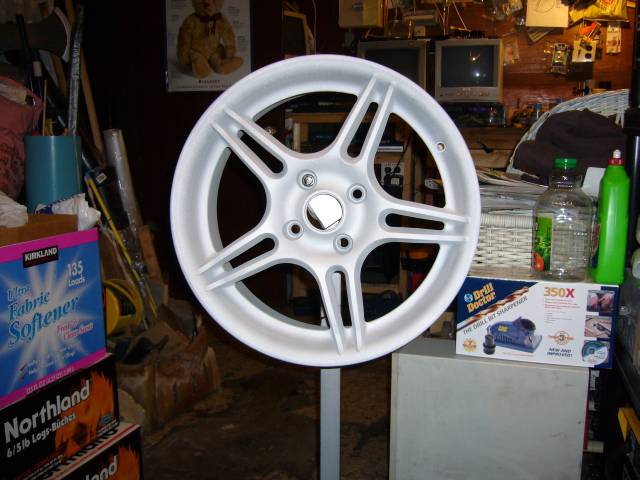
The technique I found to work best is to first lay down a very thin first coat to basically seal the metal and provide a surface for the next coat to adhere to. If you follow the instructions and lay it on thickly, it will run. As you can see from the picture, the first coat really does look awful but it gets the job done.
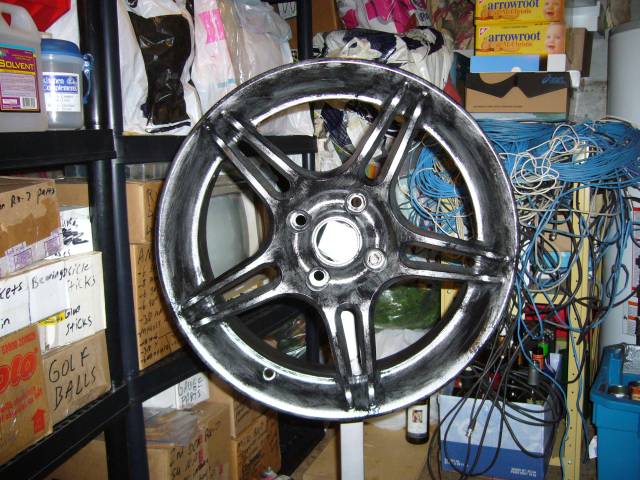
After letting the primer coat dry for about two hours, I then laid down a much thicker 2nd coat. This coat clings to the first and stays put, so even painting thickly does not produce runs or drips. Finally after the 2nd coat dries for a day, a third coat is applied to the face of each wheel to assure complete coverage on the edges.
Overall I'd say they turned out about 90% as well as I would have liked. I ended up screwing up the 1st wheel (silly me, I followed the instructions that came with the paint) and had to have it re-blasted. For being brushed, the paint is remarkably smooth but it's no powder-coat. Of course, this paint is stronger then powder coat (according to the media blaster) and it's much easier to touch up. If I had to do it again I would hire someone to spray it for me.
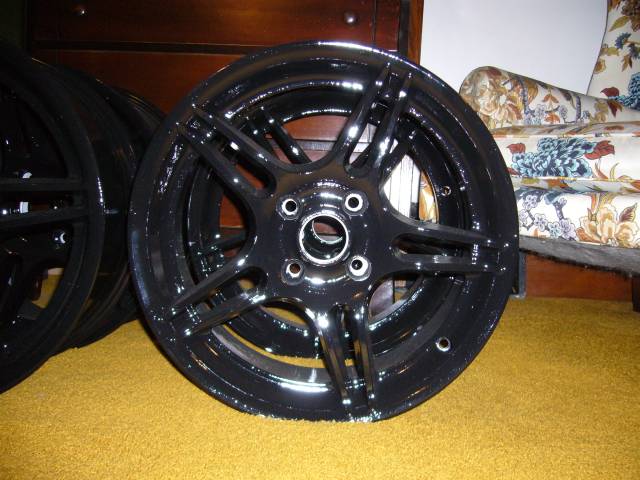
The next little fabrication task was to make radiator panels. These were made out of 2MM thick aluminum sheets after first making a cardboard template. To secure them, I welded bungs into the radiator crossmember and relay crossmember and then tapped them for M6. The panels really clean up the front of the car and provide an unobnoxious place to put some stickers.
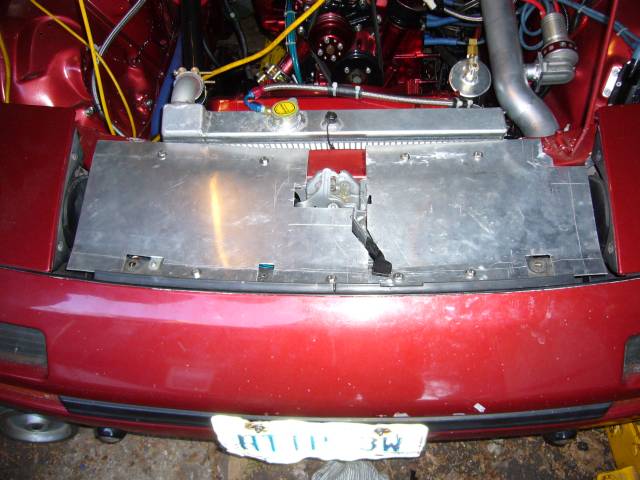
Since no one makes a manifold to fit a GT40 on a NA block with a custom intake, it's time to fabricate one! First step is to cut two small pieces of 2" SCH10 304 stainless. I had the divided TO4 flange laser cut out of stainless.
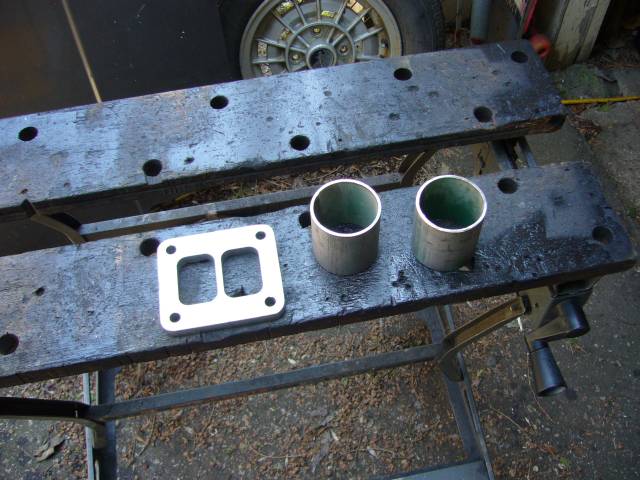
And then those pieces need to be formed to match the rectangle ports in the flange. This involves making 4 small slits with the cutting wheel, then heating the pipe with an oxy/gas torch while crushing it in the vice. After that it takes some minor blacksmithing with a hand torch, hammer and ASO (anvil shaped object) to make the final adjustments.
I have to wonder why none of the aftermarket companies produce these parts. I would gladly have paid $50 for the set to avoid the time (and burns) it took to make these.
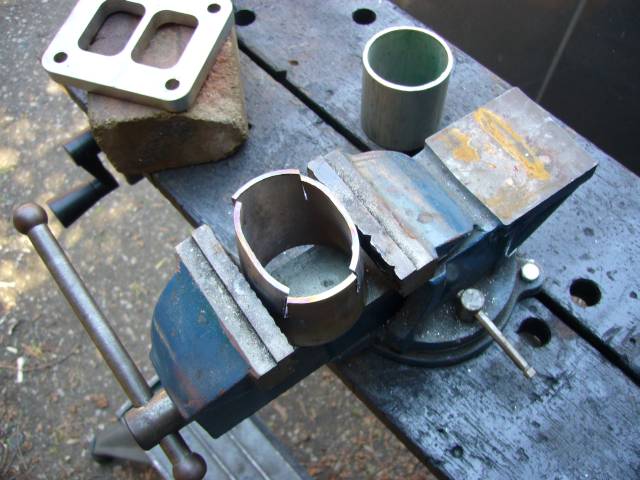
The end result is a pipe section with the end crushed to match the flange.
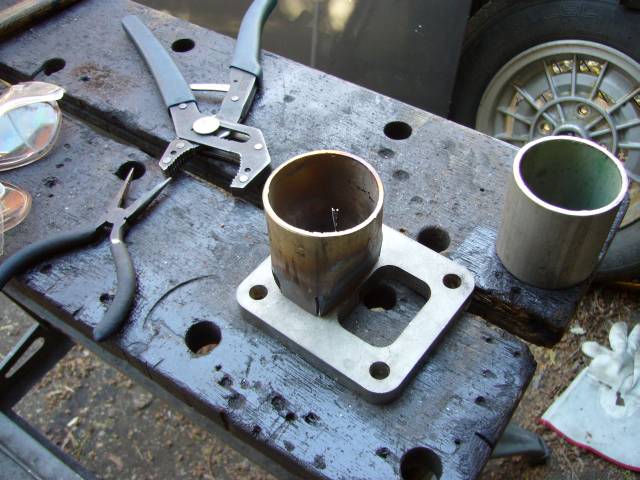
It fits well, though some minor grinding and adjustment will be required to make it perfectly. I'm planning on port matching the flange to the gasket to the turbine housing anyway (not that it really makes much of a difference).
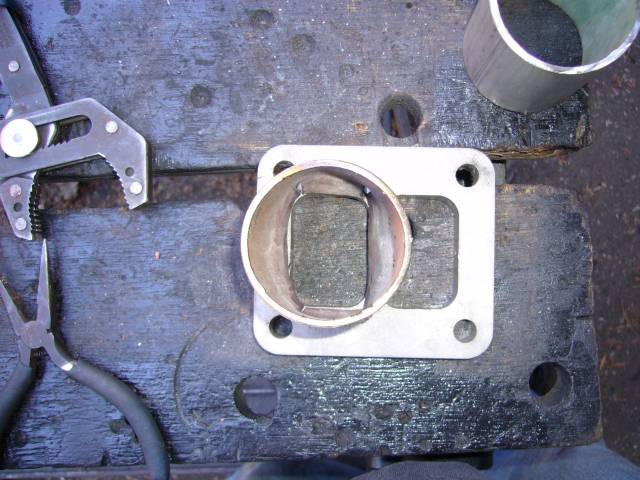
However two of them don't quite fit. The ends will need to be angled to fit flush with the flange...
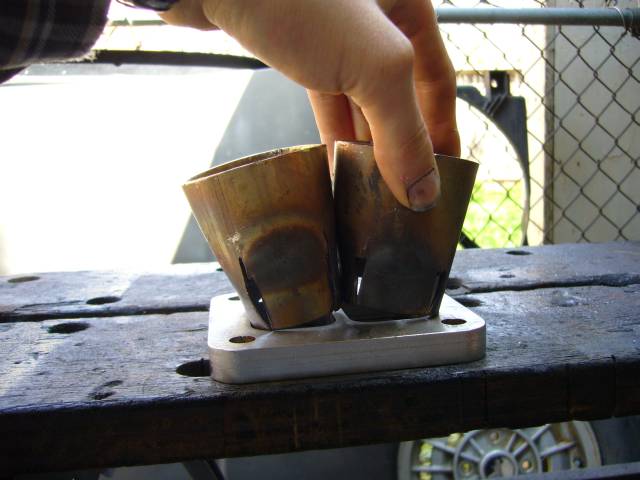
Now the fit is proper!
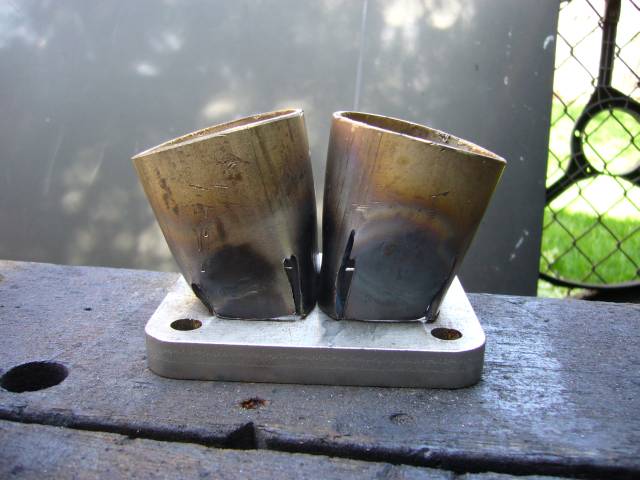
A few tack welds holds them in place. I used the flux core welder to tack things together as it's very convenient to run in the driveway and can tolerate less then ideal conditions. When the manifold is finished it will be brought inside and TIG welded.
